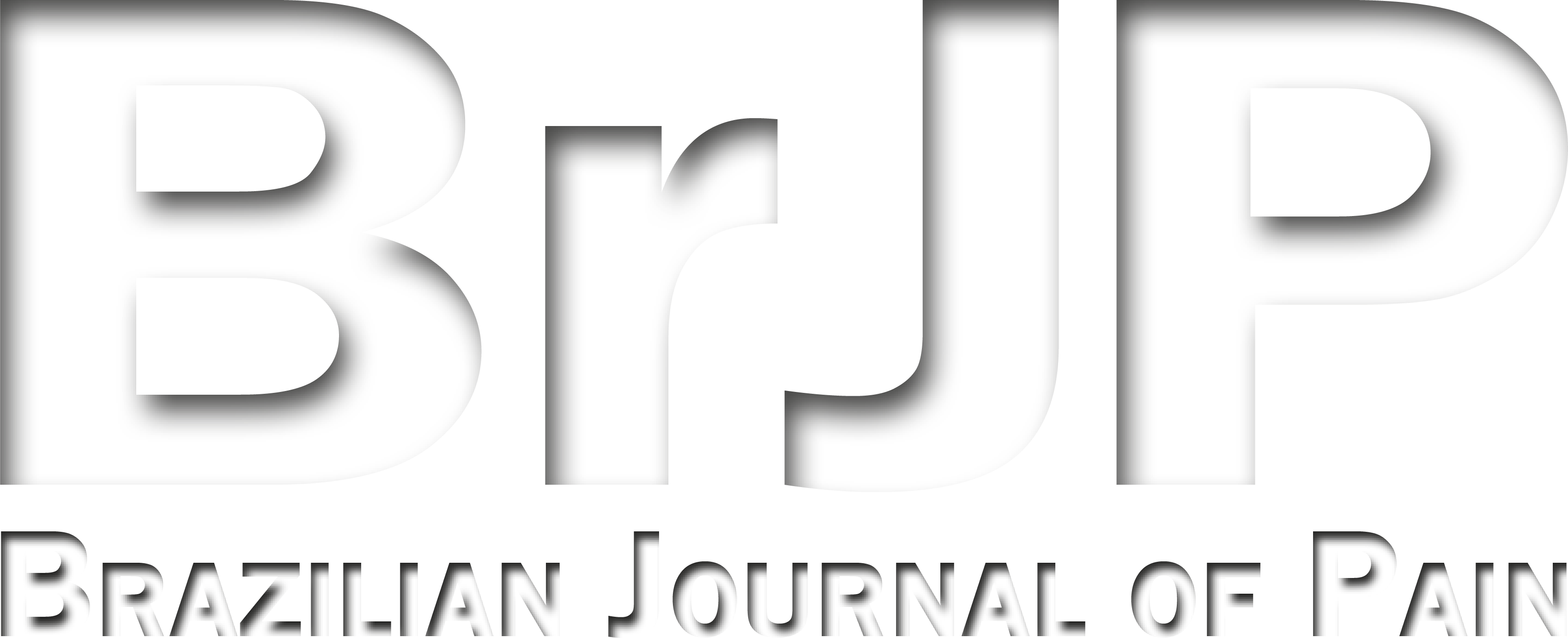Does anodal transcranial direct current stimulation over left motor cortex show body side pain-related difference in fibromyalgia?
A estimulação transcraniana por corrente contínua anódica sobre o córtex motor esquerdo apresenta diferença na dor entre os hemicorpos na fibromialgia?
Monayane Grazielly Leite Matias; Antônio Felipe Lopes Cavalcante; Karime Andrade Mescouto; Edson Meneses Silva Filho; Abrahão Fontes Baptista; Alexandre Hideki Okano; Rodrigo Pegado
Abstract
Keywords
Resumo
Palavras-chave
References
Mendonca ME, Simis M, Grecco LC, Battistella LR, Baptista AF, Fregni F. Transcranial direct current stimulation combined with aerobic exercise to optimize analgesic responses in fibromyalgia: a randomized placebo-controlled clinical trial. Front Hum Neurosci. 2016;10:68.
Clauw DJ. Fibromyalgia: a clinical review. JAMA. 2014;311(15):1547-55.
Clauw DJ, Arnold LM, McCarberg BH. The science of fibromyalgia. Mayo Clin Proc. 2011;86(9):907-11.
Rossi S, Santarnecchi E, Valenza G, Ulivelli M. The heart side of brain neuromodulation. Philos. Trans A Math. Phys Eng Sci. 2016;374(2067):20150187.
Heymann RE, Paiva Edos S, Helfenstein Jr M, Pollak DF, Martinez JE, Provenza JR, Paula AP. Brazilian consensus on the treatment of fibromyalgia. Rev Bras Reumatol. 2010;50(1):56-66.
Lefaucheur JP. A comprehensive database of published tDCS clinical trials (2005-2016). Neurophysiol Clin. 2016;46(6):319-98.
Castillo-Saavedra L, Gebodh N, Bikson M, Diaz-Cruz C, Brandao R, Coutinho L. Clinically effective treatment of fibromyalgia pain with high-definition transcranial direct current stimulation: Phase II Open-Label Dose Optimization. J Pain. 2016;17(1):14-26.
Nardone R, Höller Y, Leis S, Höller P, Thon N, Thomschewski A. Invasive and non-invasive brain stimulation for treatment of neuropathic pain in patients with spinal cord injury : a review. . 2014;37(1):19-31.
Zhu CE, Yu B, Zhang W, Chen WH, Qi Q, Miao Y. Effectiveness and safety of transcranial direct current stimulation in fibromyalgia: A systematic review and meta--analysis. J Rehabil Med. 2017;49(1):2-9.
Nasseri P, Nitsche MA, Ekhtiari H. A framework for categorizing electrode montages in transcranial direct current stimulation. Front Hum Neurosci. 2015;9:54.
Lefaucheur JP, Antal A, Ayache SS, Benninger DH, Brunelin J, Cogiamanian F, Cotelli M. Evidence-based guidelines on the therapeutic use of transcranial direct current stimulation (tDCS). Clin Neurophysiol. 2017;128(1):56-92.
Pellicciari MC, Brignani D, Miniussi C. Excitability modulation of the motor system induced by transcranial direct current stimulation: a multimodal approach. Neuroimage. 2013;83:569-80.
Zheng X, Alsop DC, Schlaug G. Effects of transcranial direct current stimulation (tDCS) on human regional cerebral blood flow. Neuroimage. 2011;58(1):26-33.
Schulz KF, Altman DG, Moher D. CONSORT 2010 Statement: Updated guidelines for reporting parallel group randomised trials. J Clin Epidemiol. 2010;63:834-40.
Hoffmann TC, Glasziou PP, Boutron I, Milne R, Perera R, Moher D. Better reporting of interventions: Template for intervention description and replication (TIDieR) checklist and guide. BMJ. 2014;348:g1687.
Wolfe F, Clauw DJ, Fitzcharles MA, Goldenberg DL, Katz RS, Mease P. The American College of Rheumatology preliminary diagnostic criteria for fibromyalgia and measurement of symptom severity. Arthritis Care Res. 2010;62(5):600-10.
Fregni F, Gimenes R, Valle AC, Ferreira MJ, Rocha RR, Natalle L. A randomized, sham-controlled, proof of principle study of transcranial direct current stimulation for the treatment of pain in fibromyalgia. Arthritis Rheum. 2006;54(12):3988-98.
Bikson M, Grossman P, Thomas C, Zannou AL, Adnan T, Mourdoukoutas AP. Safety of transcranial direct current stimulation: evidence based update 2016. Brain Stimul. 2016;9(5):641-61.
Riberto M, Marcon Alfieri F, Monteiro de Benedetto Pacheco K, Dini Leite V, Nemoto Kaihami H, Fregni F. Efficacy of transcranial direct current stimulation coupled with a multidisciplinary rehabilitation program for the treatment of fibromyalgia. Open Rheumatol J. 2011;5:45-50.
Wolfe F, Smythe HA, Yunus MB, Bennett RM, Bombardier C, Goldenberg DL. The American College of Rheumatology 1990 Criteria for the Classification of Fibromyalgia. Report of the Multicenter Criteria Committee. Arthritis Rheum. 1990;33(2):160-72.
Marques AP, Barsante Santos AM, Assumpção A, Matsutani LA, Lage LV, Pereira CAB. Validação da versão Brasileira do Fibromyalgia Impact Questionnaire (FIQ). Rev Bras Reumatol. 2006;46(1):24-31.
Hamilton M. Hamilton Anxiety Rating Scale (HAM-A). J Med. 1959;261:81-2.
Björkegren K, Wallander MA, Johansson S, Svärdsudd K. General symptom reporting in female fibromyalgia patients and referents: a population-based case-referent study. BMC Public Health. 2009;9:402.
Ablin J, Fitzcharles MA, Buskila D, Shir Y, Sommer C, Häuser W. Treatment of fibromyalgia syndrome: Recommendations of recent evidence-based interdisciplinary guidelines with special emphasis on complementary and alternative therapies. Evid Based Complement Alternat Med. 2013;2013:485272.
Baptista AF, Fernandes AMBL, Sá KN, Okano AH, Brunoni AR, Lara-Solares A. Latin American and Caribbean consensus on noninvasive central nervous system neuromodulation for chronic pain management (LAC 2 -NIN-CP). Pain Rep. 2019;4(1):e692.
Jensen MP, Day MA, Miró J. Neuromodulatory treatments for chronic pain: efficacy and mechanisms. Nat Rev Neurol. 2014;10(3):167-78.
Morya E, Monte-Silva K, Bikson M, Esmaeilpour Z, Biazoli Jr CE, Fonseca A, Bocci T. Beyond the target area: an integrative view of tDCS-induced motor cortex modulation in patients and athletes. J Neuroeng Rehabil. 2019;16(1):141.
Marlow NM, Bonilha HS, Short EB. Efficacy of transcranial direct current stimulation and repetitive transcranial magnetic stimulation for treating fibromyalgia syndrome: a systematic review. Pain Pract. 2013;13(2):131-45.
Ceko M, Bushnell MC, Gracely RH. Neurobiology underlying fibromyalgia symptoms. Pain Res Treat. 2012;2012:585419.
Matias MGL, Germano Maciel D, França IM, Cerqueira MS, Silva TCLA, Okano AH. Transcranial direct current stimulation associated with functional exercise program for treating fibromyalgia: a randomized controlled trial. Arch Phys Med Rehabil. 2022;103(2):245-54.
Submitted date:
11/27/2021
Accepted date:
04/11/2022


